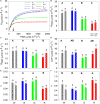Spectral Composition of Light Affects Sensitivity to UV-B and Photoinhibition in Cucumber
- PMID: 33469462
- PMCID: PMC7813804
- DOI: 10.3389/fpls.2020.610011
Spectral Composition of Light Affects Sensitivity to UV-B and Photoinhibition in Cucumber
Abstract
Ultraviolet B (UV-B) (280-315 nm) and ultraviolet A (UV-A) (315-400 nm) radiation comprise small portions of the solar radiation but regulate many aspects of plant development, physiology and metabolism. Until now, how plants respond to UV-B in the presence of different light qualities is poorly understood. This study aimed to assess the effects of a low UV-B dose (0.912 ± 0.074 kJ m-2 day-1, at a 6 h daily UV exposure) in combination with four light treatments (blue, green, red and broadband white at 210 μmol m-2 s-1 Photosynthetically active radiation [PAR]) on morphological and physiological responses of cucumber (Cucumis sativus cv. "Lausanna RZ F1"). We explored the effects of light quality backgrounds on plant morphology, leaf gas exchange, chlorophyll fluorescence, epidermal pigment accumulation, and on acclimation ability to saturating light intensity. Our results showed that supplementary UV-B significantly decreased biomass accumulation in the presence of broad band white, blue and green light, but not under red light. UV-B also reduced the photosynthetic efficiency of CO2 fixation (α) when combined with blue light. These plants, despite showing high accumulation of anthocyanins, were unable to cope with saturating light conditions. No significant effects of UV-B in combination with green light were observed for gas exchange and chlorophyll fluorescence parameters, but supplementary UV-B significantly increased chlorophyll and flavonol contents in the leaf epidermis. Plants grown under red light and UV-B significantly increased maximum photosynthetic rate and dark respiration compared to pure red light. Additionally, red and UV-B treated plants exposed to saturating light intensity showed higher quantum yield of photosystem II (PSII), fraction of open PSII centres and electron transport rate and showed no effect on the apparent maximum quantum efficiency of PSII photochemistry (Fv/Fm) or non-photochemical quenching, in contrast to solely red-light conditions. These findings provide new insights into how plants respond to UV-B radiation in the presence of different light spectra.
Keywords: LEDs; UV-B; chlorophyll fluorescence; cucumber; gas exchange; light quality; morphology.
Copyright © 2021 Palma, Castro-Alves, Morales, Rosenqvist, Ottosen and Strid.
Conflict of interest statement
The authors declare that the research was conducted in the absence of any commercial or financial relationships that could be construed as a potential conflict of interest.
Figures





Similar articles
-
Effects of UV radiation on transcript and metabolite accumulation are dependent on monochromatic light background in cucumber.Physiol Plant. 2021 Nov;173(3):750-761. doi: 10.1111/ppl.13551. Epub 2021 Sep 23. Physiol Plant. 2021. PMID: 34510478
-
Acclimating Cucumber Plants to Blue Supplemental Light Promotes Growth in Full Sunlight.Front Plant Sci. 2021 Nov 29;12:782465. doi: 10.3389/fpls.2021.782465. eCollection 2021. Front Plant Sci. 2021. PMID: 34912362 Free PMC article.
-
Lutein-mediated photoprotection of photosynthetic machinery in Arabidopsis thaliana exposed to chronic low ultraviolet-B radiation.J Plant Physiol. 2020 May;248:153160. doi: 10.1016/j.jplph.2020.153160. Epub 2020 Mar 30. J Plant Physiol. 2020. PMID: 32283468
-
Light Spectral-Ranged Specific Metabolisms of Plant Pigments.Metabolites. 2024 Dec 24;15(1):1. doi: 10.3390/metabo15010001. Metabolites. 2024. PMID: 39852344 Free PMC article. Review.
-
Morpho-physio-biochemical, molecular, and phytoremedial responses of plants to red, blue, and green light: a review.Environ Sci Pollut Res Int. 2024 Mar;31(14):20772-20791. doi: 10.1007/s11356-024-32532-6. Epub 2024 Feb 23. Environ Sci Pollut Res Int. 2024. PMID: 38393568 Review.
Cited by
-
Research Advances in Genetic Mechanisms of Major Cucumber Diseases Resistance.Front Plant Sci. 2022 May 19;13:862486. doi: 10.3389/fpls.2022.862486. eCollection 2022. Front Plant Sci. 2022. PMID: 35665153 Free PMC article. Review.
-
Potential Role of Phytochromes A and B and Cryptochrome 1 in the Adaptation of Solanum lycopersicum to UV-B Radiation.Int J Mol Sci. 2023 Aug 24;24(17):13142. doi: 10.3390/ijms241713142. Int J Mol Sci. 2023. PMID: 37685948 Free PMC article.
-
Genome-Wide Analysis of Long Non-Coding RNAs Related to UV-B Radiation in the Antarctic Moss Pohlia nutans.Int J Mol Sci. 2023 Mar 17;24(6):5757. doi: 10.3390/ijms24065757. Int J Mol Sci. 2023. PMID: 36982830 Free PMC article.
-
Non-Additive Effects of Environmental Factors on Growth and Physiology of Invasive Solidago canadensis and a Co-Occurring Native Species (Artemisia argyi).Plants (Basel). 2022 Dec 27;12(1):128. doi: 10.3390/plants12010128. Plants (Basel). 2022. PMID: 36616257 Free PMC article.
-
Light means power: harnessing light spectrum and UV-B to enhance photosynthesis and rutin levels in microtomato plants.Front Plant Sci. 2023 Sep 4;14:1261174. doi: 10.3389/fpls.2023.1261174. eCollection 2023. Front Plant Sci. 2023. PMID: 37731978 Free PMC article.
References
-
- Arakawa O., Hori Y., Ogata R. (1985). Relative effectiveness and interaction of ultraviolet−B, red and blue light in anthocyanin synthesis of apple fruit. Physiol. Plant. 64 323–327. 10.1111/j.1399-3054.1985.tb03347.x - DOI
-
- Boccalandro H. E., Giordano C. V., Ploschuk E. L., Piccoli P. N., Bottini R., Casal J. J. (2012). Phototropins but not cryptochromes mediate the blue light-specific promotion of stomatal conductance, while both enhance photosynthesis and transpiration under full sunlight. Plant Physiol. 158 1475–1484. 10.1104/pp.111.187237 - DOI - PMC - PubMed
LinkOut - more resources
Full Text Sources
Other Literature Sources

